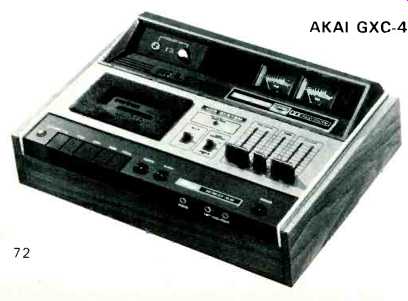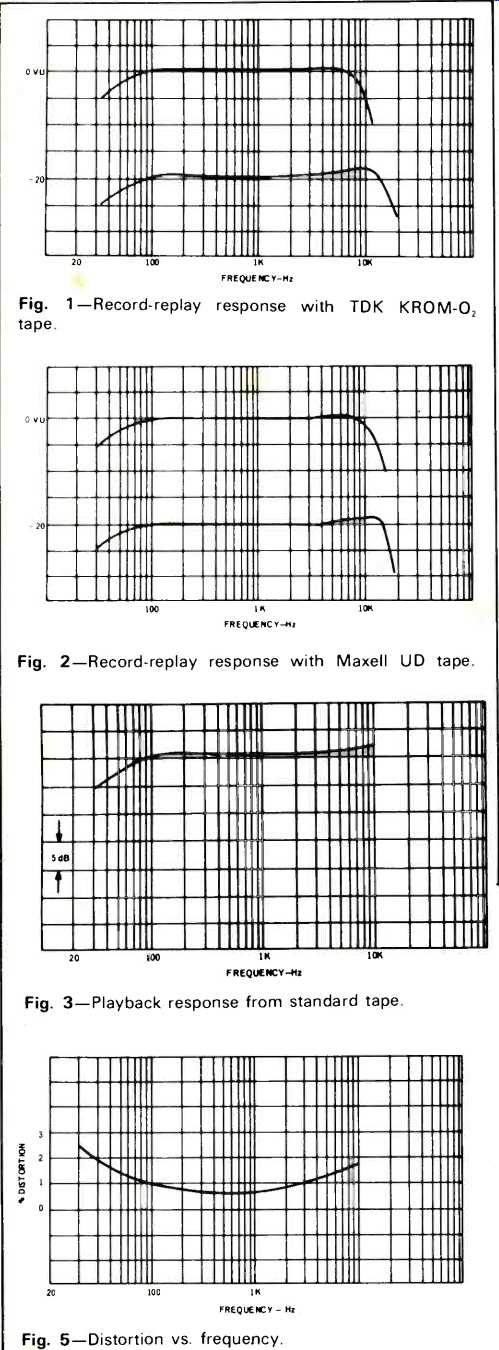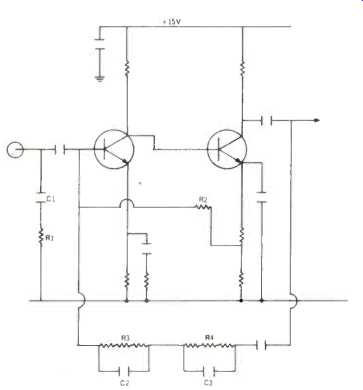
MANUFACTURER'S SPECIFICATIONS:
Frequency Response: 30 to 18 kHz (50 to 15 kHz ±4 dB) with CrO2; 30 to 16 kHz (50 to 13 kHz ±4 dB) with LN. Wow and Flutter: less than 0.12%. Signal-to-Noise: Better than 50 dB; 58 dB with Dolby. Erase: 70 dB. Outputs: Line, 0.775 V; DIN, 0.4 V; Headphone, 30 mV. Motor: Hysteresis synchronous outer-rotor type.
Dimensions: 16 in. w. x 11 1/2 in. d. x 5 in. h.
Price: $319.95.
AKAI has long had an enviable reputation for top-quality open-reel recorders-in fact, they were the first, or one of the first, to use cross-field technique. And so it is only natural that their featured entry in the cassette market would be a high quality machine using a Dolby system. Model GXC-46D uses an ADR distortion reduction system, said to eliminate almost all high frequency distortion above 8 kHz. The styling is fairly conventional with piano keys for tape control and the now almost standard slide units for input and output functions.
Reading from left to right, the key switches are as follows: RECORD, REVERSE, STOP, PLAY, and FAST FORWARD. Next comes three pushbuttons for PAUSE, EJECT, and power ON-OFF. To the right of the recessed cassette holder are switches for limiter and tape selector (CrO2 and Low-Noise) and the four slide controls-two for input level and two for output. At the top left on an angled panel is the Dolby switch with an indicator light and at the right are the two VU meters. The microphone and headphone jacks are located at the front near the AKAI nameplate and the other input and output connections (including DIN) are all at the rear. Incidentally, the limiter circuit is described as an "over-level suppressor" and it is recommended for use when recording from microphones at close range.
Circuit Details
The circuit of the 46 is fairly straightforward using 39 transistors, 39 diodes and 2 IC's. Figure 6 shows the input arrangement as it appears in the playback mode. Note that there is an RC roll-off network as well as an NFB equalizing loop. Two transistors plus a diode are used in each channel for the limiter circuit. Bias frequency is 61 kHz and the oscillator is a push-pull type employing an auto-transformer. No fewer than 16 transistors are used in the Dolby circuit-one reason for the extra cost involved.
Measurements

Fig. 1--Record-replay response with TDK KROM-O2 tape.
Fig. 2--Record-replay response with Maxell UD tape.
Fig. 3--Playback response from standard tape.
Fig. 5--Distortion vs. frequency.

Fig. 4-THD at 1 kHz. Broken line shows the effect of the limiter.

Fig. 6-Input circuit as switched for playback. R1 and C1 form a passive roll-off
network; R2 supplies d.c. stabilizing; and R3, R4, C2, C3 comprise the NFB
equalizing loop.
Figure 1 shows the record-replay response with TDK KROM-02 tape taken at 0 VU and-20 VU. The 3 dB point is about 16 kHz. Very similar results were obtained with Maxell UD Low-Noise tape, as can be seen from Fig. 2. As a matter of interest, two other tapes were tried-Maxell LN and TDK ED. The former had a rise of 1.7 dB at 10 kHz with a 3 dB point at 15.5 kHz, the latter having the same 3 dB point, but with a rise of 1 dB at 10 kHz. The Dolby system was checked but there were no significant frequency deviations.
Figure 3 shows the response from a standard tape and Fig. 4 indicates the distortion at 1 kHz up to +3 dB on the VU meter. The broken line shows the effect of the OLS limiter circuit.
Distortion vs. frequency can be seen in Fig. 5. Output at 0 VU input was 750 mV with CrO2 tape and just under 700 mV with LN tapes. Input for 0 VU was 45 mV. Signal-to-noise (unweighted) was 51 dB, increasing to 58 dB with Dolby, which is excellent. Wow and flutter came out exactly as specified at 0.12% (DIN). Tape speed was just under 1% fast and average rewind time for a C-60 cassette was 57 seconds.
Listening Tests
The GXC-46D was very easy to use: The key switches were positive without needing excessive pressure and the pause button worked without fuss. I find it an advantage to have the pause button positioned away from the bank of piano keys, as there is less chance of pushing the wrong key when in a hurry! As can be seen from the graph, the OLS limiter circuit can reduce overload distortion on high input signals although it should only be used if absolutely necessary. Summing up: the AKAI GXC-46D must be numbered among the top half a-dozen cassette recorders and can be recommended without reservation.
G. W. T.
(Audio magazine, Nov. 1973)
Also see:
Akai GX-F66RC Cassette Deck (Equip. Profile, Nov. 1982)
Akai AD-93 (DAT) Digital Audio Tape Recorder (Jun. 1988)
= = = =